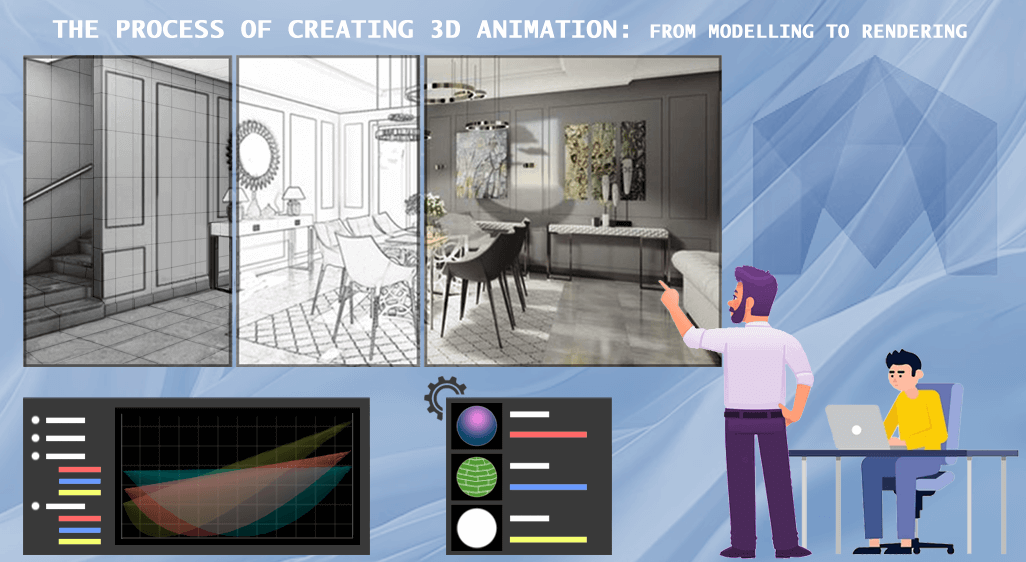Animation is a mesmerizing art form that has evolved over the years, captivating audiences of all ages with its ability to bring imaginary worlds and characters to life. Among the various forms of animation, 3D animation has gained immense popularity due to its realism and depth. This blog will take you on a journey through the fascinating process of creating 3D animation, from the initial stages of modeling to the final rendering, offering insights into the intricate techniques and tools used by animators to craft stunning visual experiences.
Conceptualization and Storyboarding
The journey of 3D animation begins with a spark of creativity—an idea, concept, or storyline. Animators brainstorm and create a rough outline of the narrative. Storyboarding, a crucial step, involves sketching key scenes and sequences, essentially creating a visual blueprint for the animation. This serves as a foundation for the entire project and helps in visualizing the flow of the story.
Modelling
Modeling is where the magic of 3D animation truly begins. In this stage, animators design and build the 3D objects, characters, and environments that will inhabit the animation. Using specialized software like Autodesk Maya, Blender, or Cinema 4D, 3D modelers construct every element, giving them shape, texture, and detail. These models serve as the digital puppets and props that animators will bring to life in the subsequent steps.
Rigging
Creating 3D models is one thing, but making them move convincingly is another challenge altogether. Rigging is the process of adding a digital skeleton, called a rig, to 3D models. This rig enables animators to manipulate and control the movement of characters and objects. Much like the joints and bones in a human body, rigging allows for realistic articulation and animation.
Animation
Now comes the part that truly defines animation: bringing still objects to life. Animators pose and manipulate the rigged models to create movement and expressions. This is a delicate process that requires a deep understanding of motion, timing, and storytelling. Frame by frame, the animation takes shape, making characters dance, run, emote, and interact with their surroundings.
Texturing and Shading
Texturing and shading give life to the models by applying textures, colors, and materials. The artist’s job is to make the 3D objects appear realistic and visually appealing. This stage involves mapping 2D textures onto the 3D surfaces, ensuring that everything looks believable under different lighting conditions.
Lighting
Lighting is a critical aspect of 3D animation. It influences the mood, ambience, and visual appeal of the animation. Animators set up various light sources, just like a cinematographer does on a live-action film set. They control factors like shadows, highlights, and color temperature to create the desired atmosphere.
Rendering
Rendering is the process of turning a 3D scene into a sequence of 2D images or frames. These frames are later compiled to create the final animation. Rendering can be a time-consuming task, depending on the complexity of the animation and the desired quality. High-quality rendering ensures that the animation appears crisp and detailed.
Compositing
Compositing is where all the elements come together. Animators integrate the rendered 3D scenes with 2D elements, such as visual effects, background plates, and other assets. This stage allows for the seamless blending of CGI with live-action footage, if necessary, to achieve a harmonious final product.
Post-Production and Editing
Similar to live-action filmmaking, 3D animation undergoes post-production and editing. Animators add final touches, such as color correction, sound design, and special effects. They also refine the animation’s pacing, ensuring that it flows smoothly and engages the audience.
Output and Distribution
Once the animation is complete, it’s time for output and distribution. Animators render the final animation into the desired format, whether it’s for the big screen, television, web, or mobile devices. Distribution methods vary, from film festivals and online platforms to broadcast networks and theaters.
Challenges and Solutions
Creating 3D animation is a labor-intensive process that comes with its own set of challenges. Here are some common obstacles animators face and their solutions:
- Complex Software: The software used for 3D animation can be intricate and overwhelming. Animators must invest time in learning and mastering these tools.
Solution: Extensive training and practice are essential. Many online tutorials and courses are available to help animators build their skills.
- Resource-Intensive: 3D animation requires powerful hardware and substantial storage space due to its high-resolution models and complex scenes.
Solution: Investing in robust hardware and cloud storage can address this issue, ensuring that animators have the necessary resources to work efficiently.
- Long Rendering Times: High-quality rendering can be time-consuming, delaying project timelines.
Solution: Optimizing rendering settings and using render farms (clusters of computers dedicated to rendering) can significantly reduce rendering times.
- Creativity and Originality: Standing out in the world of 3D animation requires creativity and original storytelling.
Solution: Constantly seeking inspiration, experimenting with new techniques, and collaborating with fellow animators can foster creativity.
- Tight Deadlines: Meeting project deadlines while maintaining quality can be challenging.
Solution: Efficient project management and effective time management are vital to ensure timely delivery without compromising quality.
The process of making 3D animation is an amazing one that calls for technical know-how, artistic talent, and storytelling. Every phase, from the first ideation to the last distribution, is crucial in creating an engaging animation that appeals to viewers all over the world. For those in the creative industry, 3D animation is a stimulating and rewarding field because, despite its difficulties, there are also significant rewards and solutions. The field of 3D animation is set for even more exciting prospects as technology develops, stretching the bounds of creativity and imagination.












